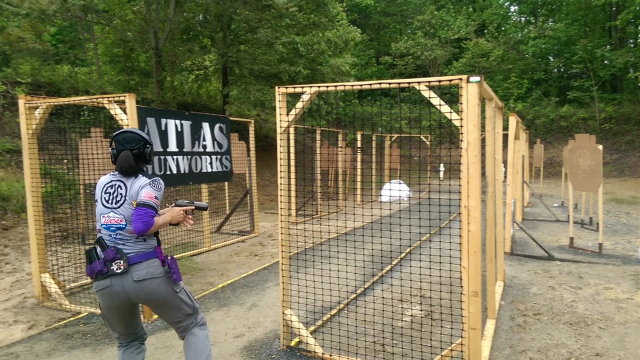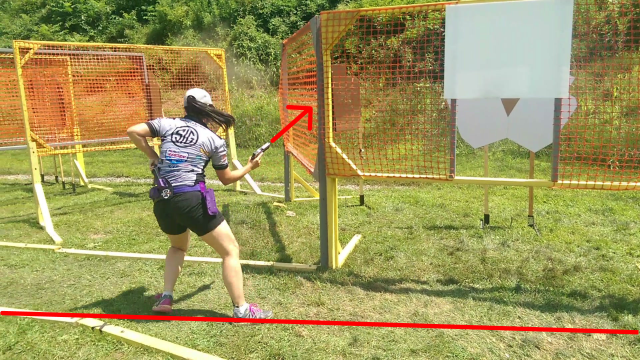Featured
Getting Started In IDPA: All You Need To Know About Gear
Published
1 year agoon

International Defensive Pistol Association (IDPA) is a shooting sport where competitors use handguns to shoot stages that are based on self-defense scenarios. With over 20,000 members and clubs and matches all over the country, IDPA is a quickly growing sport with a lot of places and opportunities to shoot, including indoor ranges in the more populated areas.
IDPA is also one of the least gear-intensive ways to get started in competitive shooting, and is a great choice if you’re looking to practice drawing your gun from a holster and work on defensive pistol skills.
Almost any pistol you’ve bought off the shelf and many customized guns have a home in IDPA. IDPA organizes pistols into different divisions, with each division having its own limits on how many rounds can be loaded in the gun at a time. That way, shooters compete only against other shooters who have similar gear.
Perhaps the most popular division is Stock Service Pistol (SSP), which includes most common factory production guns that are double action, double-action only, or striker-fired. These guns also need to be relatively unmodified and have a minimum caliber of 9mm.
If you like similar guns in single-action only, or if you like modifying your guns to include features like magazine wells, then you can shoot in Enhanced Service Pistol (ESP). SSP or ESP guns that are chambered in .45 ACP also have the option of being placed in Custom Defensive Pistol (CDP).

While the SIG SAUER P226 in the middle can be shot in either SSP or ESP, the P226 SAO on the left and the P320 with stippling on the right are ESP-only guns
All ESP, SSP, and CDP guns must fit into a special box that sets the maximum size limit for most IDPA pistols, as well as meet maximum weight requirements and maximum modification limits.
If you would like to shoot a smaller gun, then Compact Carry Pistol (CCP) limits barrel length to 4.1 inches and uses a smaller box for maximum size, but otherwise generally follows the rules for ESP. Or you can go even smaller into Back Up Gun (BUG), which includes both revolvers and semi-automatic pistols in .380 ACP or larger and with a barrel length of 3.6 inches or shorter.

Both this Kahr P9 Covert and SIG SAUER P320 can be shot in both CCP and BUG
If you want to shoot a larger wheelgun, though, then Revolver is where it’s at, as long as yours is a minimum caliber of .38 Special or .357 magnum, depending on the subdivision. They can be loaded using speedloaders or moonclips.

A Smith & Wesson 686 revolver is a popular Revolver choice.
It all sounds complicated, and there are even more details in Section 8 of the IDPA Rule Book [pdf]. If you’re confused, though, talk to your local match director before the match and ask where your gun fits in. Make sure you bring at least three to five magazines, speedloaders, or moonclips, and the rest of your gear, and they can help you figure the rest out.
Don’t worry if your gun doesn’t meet the requirements of one of the divisions, as you might also have the option of shooting in the catch-all Not For Competition (NFC) division at local matches.
Equipment for all divisions is otherwise similar:
- A holster appropriate for IDPA, worn on the strong side hip, either be inside or outside the waistband. The holster should be hard-sided holster and fully cover the trigger guard, with the muzzle vertical or pointed back. IDPA rules limit the amount of adjustability a holster can have, as well as specifics about where and how it can be worn.
- A belt for the holster to attach to, which is worn through the belt loops (although you can skip up to two of them if you need to in order to fit your gear). The holster itself should be placed at “3 o’clock” if you’re standing on a clock face facing 12 o’clock.
- Ammunition carriers, while optional, are highly recommended. They are worn on the belt opposite the holster. If you don’t have any, you can put your magazines, speedloaders, or moonclips in your pockets.

Gun, holster, belt, magazines, and magazine carriers – all you need for IDPA.
Then finally, the defining feature of IDPA: the concealment garment. It doesn’t need to be anything fancy, just something that covers your holstered gun when you have your arms out to the side in a “T”. A light jacket or even an untucked shirt can work.

The author sweeps aside the simple vest she uses as a concealment garment, so that she can access and draw her gun.
As you can see, there's no need to run out and buy expensive gear to get started competing. You’re probably already equipped and just need to find a club or match nearby. Read my other articles and I’ll walk you through all the skills and other things you need to know after you get your basic gear together. Do you shoot IDPA? Let us know in the comments below.

CZ 75 SP01 Tactical Gun Review | Gun Carrier

PODCAST: Gun Law Changes All Across America Right Now

PODCAST: How to Win Olympic Gold

PODCAST: 50 Important Ideas For Self-Defense, Self-Reliance, and Personal Safety

10 Best Gun Safes In 2022 | Gun Carrier

DP-12 | Double Barrel Pump Shotgun Gun Full Review





